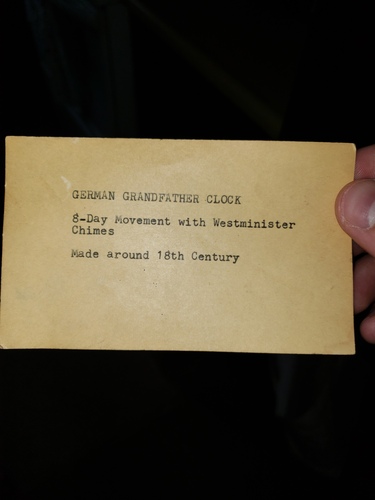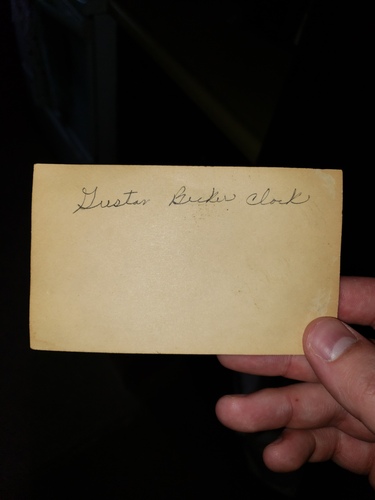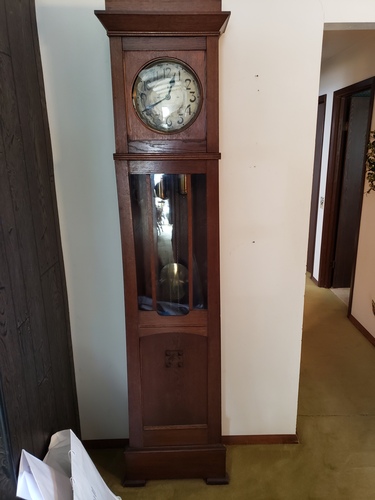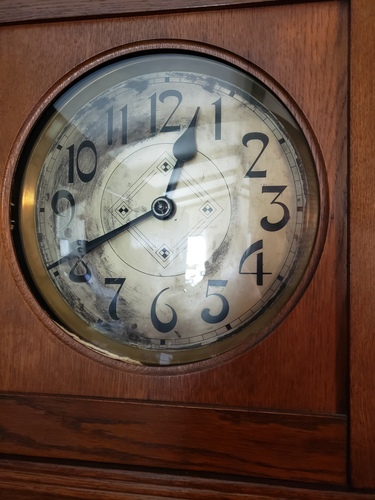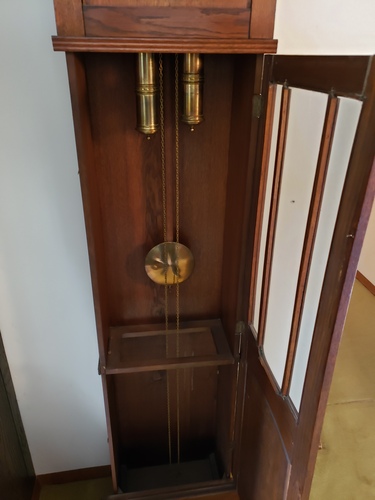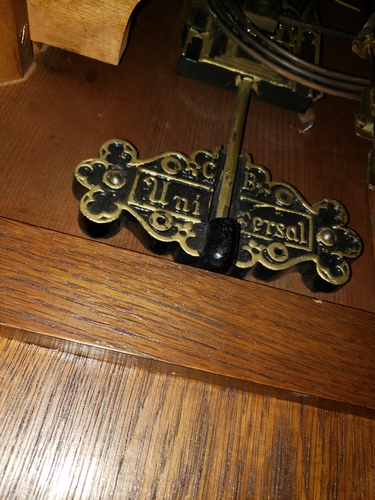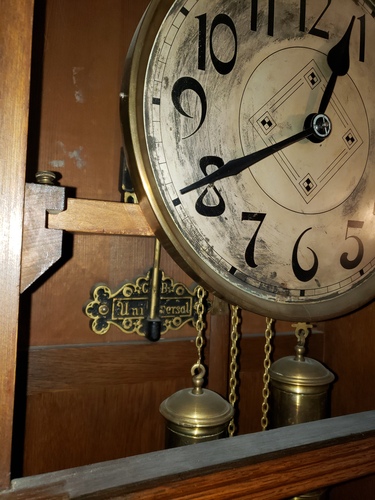8-Day Movement with Westminster Chimes, made around 18th century. Gustav Becker
My grandparents owned it, inherited it themselves.


Hello Chase,
Thank you for sending in this standing floor clock to mearto.com for an appraisal. I shall try to help you with that today.
TITLE:
Stained oak, two train, dual brass canister weights, manually pulled up weights to wind the clock, eight-day time, strike and quarterly Westminster chiming Hall clock (the modern name for this type of grandfather clock as of circa 1885), made by the United Freiburg Clock Factories A.G.(VFU), formerly Gustav Becker, Silesia, Germany, circa 1910-1915.
PROVENANCE:
My grandparents owned it, inherited it themselves.
DESCRIPTION:
Case: Height not known and approximated to be 200 cm +/-. This is a rectilinear stained oak Hall clock with a caddy top pediment above the canted and overhung hood moulding which sit above a horizontally aligned double reeded cornice with the main rectangular case below. The framed square hood door centers the glass overlying the round dial and the construction of the dial door is four pieces of quarter sawn oak placed at right angles to one another meeting as butt joints. A triple reeded cornice separates the hood from the trunk section with its full length rectangular door, the upper half is glazed and allows one to view the descent of the two brass bullet shaped canister weights on chains and the arc of the pendulum as it swings inside the case. The glazed section has two vertical wooden strips dividing the upper glass into three smaller sections. The lower half of the door contains an inset arched panel with a square with four pyramidal blocks which mimics the design seen in the dial center, a Gustav Becker/VFU logo or mark that the company used more than once for certain. The case sits on a narrow solid oak horizontally aligned base moulding with simple wooden block feet. The cast iron shaped and gilded Universal gong was part of the Becker firm from the Art nouveau era, c. 1880-1910.
Dial: The dial and movement sits on a seatboard that slides into a shelf inside the case and is secured with thumb screws. The round silvered metal dial has enameled Arabic hour chapter ring, closed minute track, steel Continental style Spade hands, and the square design with stylized pyramidal shapes in the four corners all sitting within a contrasting circle. The dial is unsigned.
Movement: Cannot really get a good clear look at the movement but is a solid brass plate movement with steel tubular pillars screwed together at the back plate, anchor recoil escapement, cut steel pinions, sprocket gears to take up the weight link chains which are manually pulled up onto the movement for winding, rack lever striking on the hour and quarter Westminster chiming on a coiled heavy Cathedral gong called the Universal gong and made by Gustav Becker/VFU.
CONDITION:
Case – The case is stained oak and of simple but fine design with the Arts & Crafts movement clearly in the mind of the casemaker.
Dial - A moderate amount of silver oxidation especially in the left hand side of the dial. Silver oxide (AG2O) is black and that is what you see muddying your dial.
Movement – A typically well-made heavy Becker movement which is original to this case, genuine throughout and likely functional.
Overall – A very fine timekeeper in a modest case of fine proportions and vertical thrust. A handsome clock that likely dates from the 1910-1915 pre-war era.
HISTORY:
Gustave Becker was born May 1819 in Silesia (Prussia). He learned clockmaking by visiting Viennese, Swiss and German clockmakers. By 1841 he was employed with a master clockmaker named Happacher in Vienna, making Viennese wall regulators. He traveled back to Silesia, married and set up a shop in the town of Freiburg. There he began to produce Viennese style wall clocks in a small factory with the help of school boys. In 1850 he was given some machinery by the government with the proviso that he hire 80 boys from poverty stricken families. He had to feed them and teach them the clockmaking trade. In 1852 his clock designs won a state medal. By 1854 he was awarded larger contracts. With these finances he was able to build a case making shop nearby. By 1860 his weight driven clocks were well known for quality of the movement and of the case materials and design. His name became a household word. By 1875 his clock output reached 300000/year and he was awarded the gold crown by Kaiser Wilhelm. His brass movements won awards throughout Europe and Australia between 1862 and 1885. By 1880 his business was hurt by the production of cheaper spring driven clocks from Germany. This forced Becker to compete in this market also. Many of the machines at his factory, which were steam driven, were of unique design for specialized purposes. His first priority was to combine efficiency with excellence of workmanship. Gustav died suddenly in Sept. 1885. Freiburg became a clockmaking center where several factories continued to follow Becker's model as a joint venture called the "United Freiburg Clock Factories A.G., formerly Gustav Becker”. This firm used the Becker name as Becker A.G. and continued successfully until 1926, when it was taken over by Junghans. One of the characteristics of later Becker clocks (1880-1885) was the use of embossed brass in the center of his dials and on his brass weights and pendulum bobs. Occasionally we see square dials on Austrian wall clocks. Becker had numerous trademarks over the years; the most well-known and earliest was an anchor with a large GB alongside. These would appear on the rear plate of the movement. Gustav Becker clocks date from 1850 to 1933, with specific dates tied to clock serial numbers by patent information, sale catalogs, trade advertisements, contemporary articles, dated presentation inscriptions, and other available information. There was a catalog issued in 1912 that had clock resembling yours but your example is not listed in that catalog. Catalogs did not put in all of their merchandise, in fact, most models were omitted.
COMPARABLES:
~https://www.liveauctioneers.com/item/69720915_gustav-becker-art-nouveau-long-case-clock (Sold for $325 in 2019)
~https://www.liveauctioneers.com/item/58774426_oak-tall-case-clock-with-chimes (Sold for $90 in 2018)
~https://www.liveauctioneers.com/item/52611921_gustav-becker-tall-case-clock (Sold for $110 in 2017)
~https://www.liveauctioneers.com/item/50137629_gustav-becker-tall-case-clock (Sold for $125 in 2017)
~https://www.invaluable.com/auction-lot/gustav-becker-oak-case-grandfather-clock-93-c-bab4f008e0 (Sold for $500 in 2019)
~https://www.invaluable.com/auction-lot/c-1920s-gustav-becker-dom-gong-grandfather-clock-2000-c-7a949b68f0 (Sold for $130 on 2017)
COMMENTARY:
Hall clocks, were once grand superbly carved Victorian clocks that started in the 1880s in Providence, Rhode Island. Entrepreneur Walter Durfee came up with the concept and then used JJ Elliott in London to make his movements and dials and J. Harrington of London to make hi wonderful tubular chimes. That is when the term Hall clock was first used. The originals were quite extraordinary in every way: massive movements, superbly carved mahogany cases, splendid signed brass dials and chiming on sets of long silvered brass tubular chimes. Within twenty years, the German clockmakers were supplying the vast majority of these clocks, now toned down to simple round unsigned dials, non-carved cases, chiming on coiled metal gongs, but still the Germans, while copying the Anglo-American Hall clock, made a better and less expensive Hall clock than either those in England or in American could make and for a lower price point. None was better at it than the Gustav Becker clock company which continued on until the mid-1930s. Both World Wars came close to destroying the German clockmaking industry, but it survived and did well in the second half of the 20th century, once again. However, it does not translate into expensive clocks today. The value in the Hall clock was then, and is today, dependent almost solely on the amount of carving in the case.
PRICING:
A Hall clock from the company originally managed by Gustav Becker, this is an interesting Arts & Crafts inspired timepiece. I always like the simple lines of grandfather clocks, just my own preference. From a value point of view, the fair market value, as you can see from the comparables, for your clock would fall into a range of $250-$300 of offered for sale today in its current condition. I hope you found this appraisal of some interest, and I enjoyed inspecting and appraising your family heirloom Hall clock. I would keep it clean, safe and running if possible.
Thank you for choosing mearto.com for this appraisal.
My best,
David
Please log in to your Mearto account to contact this seller or make an offer on this item.
